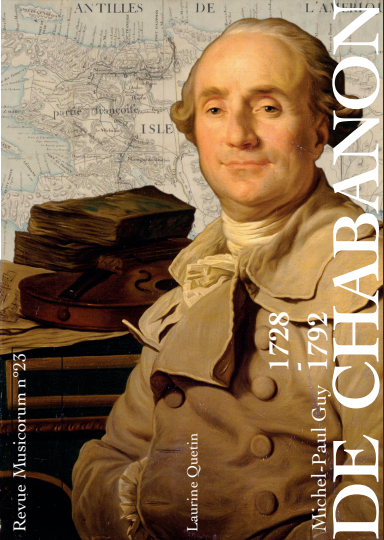Revue Musicorum

M.P.G. de Chabanon 1728-1792

Placez le curseur sur les flèches pour afficher les titres.
Quatrième de couverture
This volume takes a fresh look at the articles published in Revue Musicorum concerning the work of M.P.G. de Chabanon in the Age of Enlightenment. Combining musical practice (the violin) and composition, both based on a precise knowledge of musical science, Chabanon was an essential link between men of letters and music
professionals. Let's pay tribute to him!

In 1773, M.P.G. de Chabanon provided the composer F.J. Gossec with the opportunity of writing his first « tragédie lyrique ». It was in the form of a libretto called Sabinus that had just been adapted from Chabanon’s 1762 tragedy, Eponine. The analysis of the opera shows how the two elements of an operatic work (text and music) adjust to the new aesthetic requirements of the 1770s. The bad reviews received by the work deserve to be examined closely, for they reveal that the fundamental function of music in an operatic work was still largely overlooked by most spectators.
Sabinus, an opera from M. P. G. de Chabanon and F. J. Gossec

This issue focuses on the figure of the French diplomat Pierre-Michel Hennin whom his correspondence with Michel Paul Guy de Chabanon is published. An Enlightenment man of culture with a passion for art and a strong interest in drama and opera, Hennin served in Geneva from 1765 to 1778 when Voltaire was living at Ferney in neighbouring France. If Hennin was both a critical and partial observer of the often troubled political life of Geneva, he was also one of Voltaire’s interlocutors
at a time when the presence-absence of Rousseau still marked the debate on simplicity and beauty in art.
The letters of P.M.Hennin and M.P.G. de Chabanon

Portrait de M.P.G. de Chabanon par J.S. Duplessis, musée des Beaux-Arts d’Orléans (François Lauginie), MBAO 392
One year after their “tragédie lyrique” Sabinus, M.P.G.de Chabanon and F.J.Gossec resumed their collaboration with La Nativité, a piece performed at the “Concert Spirituel” on Christmas eve in 1774. This work, based on the proclamation of Christ’s birth to the shepherds, is made up of eight scenes structured by five choruses. In the context of an oratorio, librettist and composer depicted a charming and moving pastoral that was hailed by the public whenever it was revived.

La Nativité, 1774, M.P.G. de Chabanon and F.J. Gossec, an oratorio or a pastoral ?
Published as late as 1788, M.P.G. de Chabanon’s comedy L’esprit de parti ou Les Querelles à la mode never went to the stage. Since it was probably written before Chabanon’s Observations sur la musique (1779), one can wonder whether it had not been meant to expose the damaging effects of those typically French musical quarrels. A careful analysis of its five acts does indeed betray its author’s familiarity with the dramatic world. Close to Diderot’s ideas on the conception of a type of moral drama, Chabanon made sure that musical and family quarrels were inextricably linked. In the handling of a complex yet light-hearted plot he did, however, lack the skills of a Beaumarchais, whose Mariage de Figaro he much admired.

Tudomèle or Aletha ? a musical quarrel
« Adieu donc mon cher poulet » Action dramatique et expression musicale dans Le Cadi dupé de C.W. Gluck
In 1761, Gluck took up Lemonnier’s libretto to Le Cadi dupé and adapted it for the Vienna stage. He also came up with an entirely new musical score displaying a new type of musical writing and a highly original use of instrumental colours. Created halfway between the Ballet Don Juan and the opera Orfeo ed Euridice, this comic opera illustrates the close links that Gluck managed to introduce between action and music.

Close links between action and music in Le Cadi dupé de Gluck